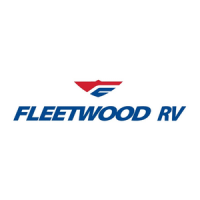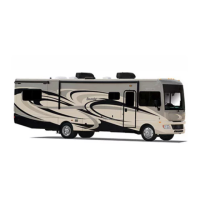Do you have a question about the Fleetwood 2008 Southwind and is the answer not in the manual?
Crucial safety information for operating the vehicle.
Check warning devices like CO detectors, smoke alarms, and seat belt warnings for proper operation.
Warrants the motor home structure, systems, and appliances against manufacturing defects for one year.
Excludes automotive chassis, tires, batteries, misuse, accidents, normal wear, and consequential damages.
Return motor home to selling dealer or authorized dealer for warranty service; contact Owner Relations if unsatisfied.
Report safety defects to NHTSA and Fleetwood Owner Relations to potentially trigger recalls.
Indicates a potentially hazardous situation which, if not avoided, could result in death or serious injury.
Indicates a potentially hazardous situation which, if not avoided, may result in minor or moderate injury.
Operator is responsible for proper and safe loading; exceeding weight limits changes handling and response.
Guidelines for towing, including weight limits, tire capacities, and the need for supplemental brakes.
Critical for vehicle safety and performance.
Essential for safe operation.
Procedures for weighing your loaded motor home at a public weigh station to determine axle and gross weights.
Explains risks of overloading including tire failure, brake failure, and loss of vehicle control.
Tips on loading heavy items lower, securing items, and managing water weight for safe operation.
Information on tire selection, maintenance, and age; periodic inspection recommended.
Maintaining proper inflation pressure is vital for safety, tire life, and stability. Check pressure regularly.
Explains the importance of correct tire pressure for safety, handling, and tire wear.
Check tire pressure every two weeks, monthly, or before major trips. Check when tires are cold.
Provides steps to take in case of sudden tire failure, including maintaining stability and braking.
Seat belts restrain occupants in collisions; best restraint when seat back is upright and belts fit snugly.
Details how lap and shoulder belts work, how to use them properly, and available longer assemblies.
Requires use of safety seats for children; check local and state laws for specific requirements.
Proper positioning of lap and shoulder belts for children; seatbacks must be upright.
Motor home driving differs from cars; learn new techniques for safe operation, especially downhill.
Select lower gears to use engine braking for speed control when going downhill.
Information on fuel recommendations, vapor pressure, and safe refueling practices.
Guidelines for safe refueling, including turning off the engine, avoiding static discharge, and not overfilling.
Advises on preventing static electricity build-up during refueling to avoid flash fires.
Carbon monoxide is deadly; understand its sources, symptoms, and precautions to prevent poisoning.
Information on the CO detector/alarm, its function, testing, and what to do if it sounds.
Preferred towing methods and information to provide to a tow truck operator.
Identifies emergency exit windows and provides instructions on how to use them for escape.
Explains causes of condensation from daily activities and provides tips to manage humidity.
Steps RV owners can take to reduce mold occurrence: check items, vacuum, clean, ventilate, and clean spills.
Extremely critical safety topic.
Tips for preventing fires while traveling or camped, including unattended cooking and open flames.
Details the battery-powered smoke detector/alarm, its testing, maintenance, and battery replacement.
Potable water is available from external city water hookup or on-board storage tank.
Fills the tank via city water pressure with bypass valve or gravity fill connection.
Sanitize tank and piping with chlorine bleach solution to discourage bacteria growth.
Management of grey and black water
Essential procedure for waste disposal.
Drain black tank at least 3/4-full into approved station. Add water to cover bottom after draining.
Two battery systems: chassis for engine start, house for living area power.
Details of the RV's electricals.
Check battery cover/case for cracks, clean terminals. Wash with diluted baking soda solution.
Batteries charged by alternator, converter, or generator. Avoid charging for extended periods.
Provides 120-volt AC service for appliances like AC, TVs, ovens via generator or shore cord.
Protects against electrical shocks in bathrooms/galleys. Test monthly. Disconnects outlet if hazard detected.
Provides electrical self-containment when utility power is unavailable; controls are at generator and panel.
Safety precautions for generator operation, including exhaust gas awareness, ventilation, and fire prevention.
Handle Propane with respect and caution; common sense and regular maintenance prevent hazards.
Immediate steps if Propane is smelled: extinguish flames, turn off supply, ventilate, leave area.
Visually check piping and fittings. Check system if garlic/rotten egg odor or hiss is detected.
Permanently installed detector alerts to dangerous Propane levels. Test regularly.
Read manufacturer's instructions. Purge air from lines by lighting range burner first.
Operates on Propane or 120-volt AC. Has automatic shut-off. Check if full before lighting.
Propane oven and burners. Requires adequate ventilation for combustion air to avoid asphyxiation.
Fiberglass finish requires maintenance to prevent dulling/fading from sun, moisture, pollutants.
Procedure to maintain weatherproof integrity; inspect sealants around openings and reseal if cracked.
Inspect sealants around windows, doors, joints, roof components, and moldings every three months.
Provides guidelines for usage conditions, severe climates, full-timing, and owner manuals.
Includes short-term steps plus engine running, battery removal, fuel stabilizer, tire pressure checks.
Critical for cold weather storage.
Detailed procedure for winterizing water system.
Crucial safety information for operating the vehicle.
Check warning devices like CO detectors, smoke alarms, and seat belt warnings for proper operation.
Warrants the motor home structure, systems, and appliances against manufacturing defects for one year.
Excludes automotive chassis, tires, batteries, misuse, accidents, normal wear, and consequential damages.
Return motor home to selling dealer or authorized dealer for warranty service; contact Owner Relations if unsatisfied.
Report safety defects to NHTSA and Fleetwood Owner Relations to potentially trigger recalls.
Indicates a potentially hazardous situation which, if not avoided, could result in death or serious injury.
Indicates a potentially hazardous situation which, if not avoided, may result in minor or moderate injury.
Operator is responsible for proper and safe loading; exceeding weight limits changes handling and response.
Guidelines for towing, including weight limits, tire capacities, and the need for supplemental brakes.
Critical for vehicle safety and performance.
Essential for safe operation.
Procedures for weighing your loaded motor home at a public weigh station to determine axle and gross weights.
Explains risks of overloading including tire failure, brake failure, and loss of vehicle control.
Tips on loading heavy items lower, securing items, and managing water weight for safe operation.
Information on tire selection, maintenance, and age; periodic inspection recommended.
Maintaining proper inflation pressure is vital for safety, tire life, and stability. Check pressure regularly.
Explains the importance of correct tire pressure for safety, handling, and tire wear.
Check tire pressure every two weeks, monthly, or before major trips. Check when tires are cold.
Provides steps to take in case of sudden tire failure, including maintaining stability and braking.
Seat belts restrain occupants in collisions; best restraint when seat back is upright and belts fit snugly.
Details how lap and shoulder belts work, how to use them properly, and available longer assemblies.
Requires use of safety seats for children; check local and state laws for specific requirements.
Proper positioning of lap and shoulder belts for children; seatbacks must be upright.
Motor home driving differs from cars; learn new techniques for safe operation, especially downhill.
Select lower gears to use engine braking for speed control when going downhill.
Information on fuel recommendations, vapor pressure, and safe refueling practices.
Guidelines for safe refueling, including turning off the engine, avoiding static discharge, and not overfilling.
Advises on preventing static electricity build-up during refueling to avoid flash fires.
Carbon monoxide is deadly; understand its sources, symptoms, and precautions to prevent poisoning.
Information on the CO detector/alarm, its function, testing, and what to do if it sounds.
Preferred towing methods and information to provide to a tow truck operator.
Identifies emergency exit windows and provides instructions on how to use them for escape.
Explains causes of condensation from daily activities and provides tips to manage humidity.
Steps RV owners can take to reduce mold occurrence: check items, vacuum, clean, ventilate, and clean spills.
Extremely critical safety topic.
Tips for preventing fires while traveling or camped, including unattended cooking and open flames.
Details the battery-powered smoke detector/alarm, its testing, maintenance, and battery replacement.
Potable water is available from external city water hookup or on-board storage tank.
Fills the tank via city water pressure with bypass valve or gravity fill connection.
Sanitize tank and piping with chlorine bleach solution to discourage bacteria growth.
Management of grey and black water
Essential procedure for waste disposal.
Drain black tank at least 3/4-full into approved station. Add water to cover bottom after draining.
Two battery systems: chassis for engine start, house for living area power.
Details of the RV's electricals.
Check battery cover/case for cracks, clean terminals. Wash with diluted baking soda solution.
Batteries charged by alternator, converter, or generator. Avoid charging for extended periods.
Provides 120-volt AC service for appliances like AC, TVs, ovens via generator or shore cord.
Protects against electrical shocks in bathrooms/galleys. Test monthly. Disconnects outlet if hazard detected.
Provides electrical self-containment when utility power is unavailable; controls are at generator and panel.
Safety precautions for generator operation, including exhaust gas awareness, ventilation, and fire prevention.
Handle Propane with respect and caution; common sense and regular maintenance prevent hazards.
Immediate steps if Propane is smelled: extinguish flames, turn off supply, ventilate, leave area.
Visually check piping and fittings. Check system if garlic/rotten egg odor or hiss is detected.
Permanently installed detector alerts to dangerous Propane levels. Test regularly.
Read manufacturer's instructions. Purge air from lines by lighting range burner first.
Operates on Propane or 120-volt AC. Has automatic shut-off. Check if full before lighting.
Propane oven and burners. Requires adequate ventilation for combustion air to avoid asphyxiation.
Fiberglass finish requires maintenance to prevent dulling/fading from sun, moisture, pollutants.
Procedure to maintain weatherproof integrity; inspect sealants around openings and reseal if cracked.
Inspect sealants around windows, doors, joints, roof components, and moldings every three months.
Provides guidelines for usage conditions, severe climates, full-timing, and owner manuals.
Includes short-term steps plus engine running, battery removal, fuel stabilizer, tire pressure checks.
Critical for cold weather storage.
Detailed procedure for winterizing water system.
| Manufacturer | Fleetwood |
|---|---|
| Model | Southwind |
| Year | 2008 |
| Category | Motorhomes |
| Width | 8' 5" |
| Gross Vehicle Weight Rating (GVWR) | 22, 000 lbs |
| Fuel Type | Gasoline |
| Engine | Ford V10 |
| Generator | Onan 5.5 kW |
| Fuel Capacity | 75 gal |












